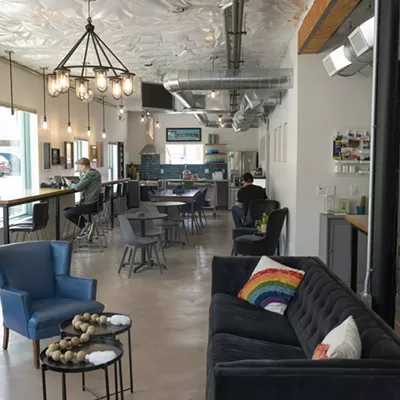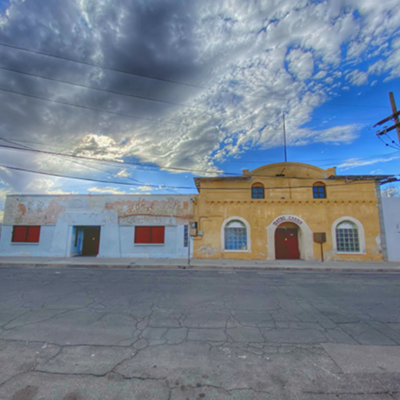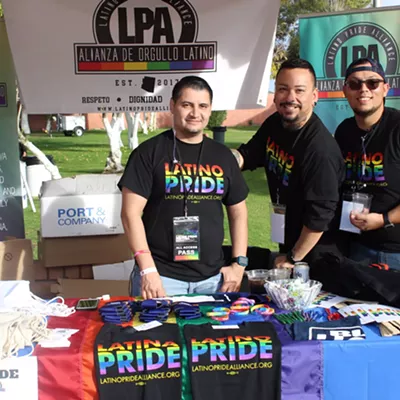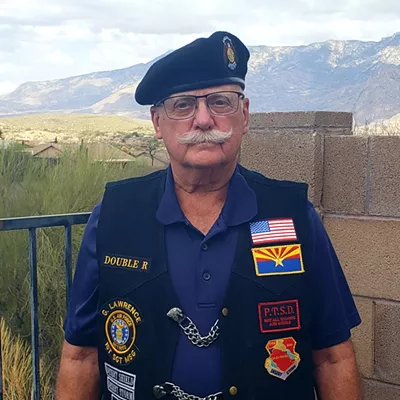A freight train roars past the open backdoor, barely 50 feet away, on the other side of a graveyard for old wooden pallets. The nearby tracks and abandoned loading dock attest to a colorful past for this old warehouse at 191 E. Toole Ave., built in 1923, but the train can't drown out the boombox spitting rhythms for a handful of break-dancers on a big sheet of linoleum.
Behind the dancers, a young artist sits on the floor, surrounded by her paints and dwarfed by the mural of downtown Tucson she is carefully crafting. In another room, a half-dozen high school students are learning to sew on donated machines and threadbare mannequins. A barrel of old jeans awaits their attention, and they're looking forward to seeing what the artists in the silk-screening studio do with a batch of blank T-shirts.
Two young women sit before a large computer monitor editing a video. At a long table, several more teens clip artwork out of donated magazines to illustrate their own handmade zines. The instructors are largely a dedicated collection of teachers and 20-somethings who sought knowledge and companionship in this same youth club a decade ago.
In the front of the building, kids lounge in a living-room setting and peruse books on the library shelves. After all, it's daytime, after school; the scene is a bit different here at night.
In the back, near the rumbling train, a crew inspects the portable stage, spread across half of the dance floor like the wreckage of a pirate ship. Due to city red tape, they must erect and tear down the stage for each weekend's rock concerts.
But that doesn't matter much. What does matter is that Skrappy's is back. The youth collective's official grand reopening happened on Friday, Oct. 30.
They'd love to build a permanent stage—in fact, they did already, but city inspectors told them that they needed to spend as much as $20,000 to reinforce beams in the vast basement beneath them.
So Skrappy's den mother and founder, Kathy Wooldridge, plans more all-ages rock concerts to earn a few bucks. (She also wants to open up those basement rooms for more free classes.) It's interesting that the very activity that brings in the most money has also brought Skrappy's its notoriety, thanks to a few outbreaks of violence at those concerts.
"Most people think we're a bar, because we put on so many shows," says Wooldridge, who has the jovial demeanor of a woman who has seen everything during her 15 years of steering Skrappy's. "People either love us or they hate us. It's the age group we work with."
She explains further. "We're an outlet. Even though we can't afford free classes, we have free classes. We have a high rate of success of getting kids more involved in a positive energy instead of going out and doing drugs or graffiti."
When Wooldridge's sons, Dusty and Eli, were 15 and 13, they bemoaned the fact that there was nothing cool for them to do after school, except get in trouble. They were also in a rock band and wanted a venue where underage bands could play for their peers. The boys raised $3,000 themselves, and Skrappy's was born in 1995, at a site near Prince and Oracle roads.
"Not all kids have money," says Wooldridge, "so that made it hard to keep up with the bills. We had kids coming in hungry, runaways, things like that, so we started meeting with various social services. That's how we went from being a music venue into (having) more services. As each group grows, it's always changing."
Skrappy's has had a nomadic existence.
"They wouldn't renew our lease on Broadway," says Wooldridge, referring to Skrappy's previous home at Broadway Boulevard and Fifth Avenue, "and we were homeless a little over two years, since the summer of 2007. That corner has been dead ever since. We were at the Boys and Girls Club for a little while, just doing after-school programming. No shows. (But) all the B Boys need is linoleum and an iPod."
B Boys stands for the break-dancers, led by instructor Nate Camacho, who's been coming to Skrappy's since 1999, when he was 13.
"I would've been in a whole lot of trouble if I was just out on the streets," recalls Camacho. "I heard about Skrappy's through word of mouth. Back then, there weren't very many break-dance competitions, so you would just rush down there. Ever since, we've been coming to Skrappy's. After I teach my classes, we have another good two or three hours of practice. We're here every Wednesday and Friday from 4 to 8 (p.m.)."
Aaron Burch teaches art every Tuesday afternoon. "Makeshift, do it yourself—that's what I teach them," he says, "how to create their art and do everything themselves with low amounts of money and resources. That's the problem young artists have: not being able to afford supplies. I make sure they're self-sufficient."
Burch adds, "I also help out with the screen-printing studio. We're getting it off the ground right now, working on our designs, ideas that we've been exploring. We're starting an online Web store pretty soon, and we have to get up our inventory. We're hoping that will turn into a retail space here, or somewhere downtown."
Liz Albert teaches Staples and Stitches, a popular sewing class at Skrappy's; all eight machines were occupied on a recent Wednesday afternoon. During the rest of the day, Albert is a teacher at Paulo Freire Freedom School in Tucson, designs her own clothing line and is a social worker.
"I started coming to Skrappy's in late 1997," recalls Albert, "and I'm 30 now. I've been working as a designer for 10 years, and nothing feels better than making your own things, whether it's art or music. When you grow up at Skrappy's, there's always opportunity to impart that feeling to a new generation, but every generation is different."
About their current project, she says, "I'm teaching them basic redesign skills, where we take vintage clothes out of your closet, rip them apart and put them back together in a more modern form. We also learn how to put on a fashion show, deal with boutique owners and open a storefront. As I learn, they learn as well."






